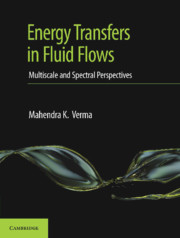Book contents
- Frontmatter
- Dedication
- Contents
- Preface
- Acknowledgments
- Part I FORMALISM OF ENERGY TRANSFERS
- Part II FLOWS WITH SCALARS
- Part III FLOWS WITH VECTORS
- Part IV MISCELLANEOUS FLOWS
- 26 Rotating Turbulence
- 27 Flow with a Tensor
- 28 Shell Models of Turbulence
- 29 Burgers Turbulence
- 30 Compressible Turbulence
- 31 Miscellaneous Applications of Energy Transfers
- 32 Conclusions
- Appendix A Power Law Physics
- Appendix B Wealth Distribution and Cascade in an Economy
- Appendix C Renormalization Group Analysis of Hydrodynamic Turbulence
- Notation
- References
- Subject Index
32 - Conclusions
from Part IV - MISCELLANEOUS FLOWS
Published online by Cambridge University Press: 12 June 2019
- Frontmatter
- Dedication
- Contents
- Preface
- Acknowledgments
- Part I FORMALISM OF ENERGY TRANSFERS
- Part II FLOWS WITH SCALARS
- Part III FLOWS WITH VECTORS
- Part IV MISCELLANEOUS FLOWS
- 26 Rotating Turbulence
- 27 Flow with a Tensor
- 28 Shell Models of Turbulence
- 29 Burgers Turbulence
- 30 Compressible Turbulence
- 31 Miscellaneous Applications of Energy Transfers
- 32 Conclusions
- Appendix A Power Law Physics
- Appendix B Wealth Distribution and Cascade in an Economy
- Appendix C Renormalization Group Analysis of Hydrodynamic Turbulence
- Notation
- References
- Subject Index
Summary
In this book, we describe nonlinear energy transfers in incompressible and compressible hydrodynamics; scalar flows including stably stratified and thermal convection; vector flows including magnetofluids, electron magnetohydrodynamics (MHD), tensor flows, etc. After introducing such flows, we describe the formalism of mode-to-mode energy, enstrophy, kinetic helicity, and magnetic helicity transfers in respective flows.
Using the formulas for the mode-to-mode transfers, we can easily derive fluxes and shell-to-shell transfers for the corresponding quantities (e.g., kinetic energy, kinetic helicity, etc.). Complex flows like thermal convection and MHD have various kinds of energy fluxes that are covered in this book. For anisotropic flows, the useful transfer functions are ring-to-ring transfers, and energy transfer from u1 to via pressure. In the book we also describe various phenomenologies of energy flux and spectrum, and compare the phenomenological predictions with numerical and experimental results.
This book also includes discussions on energy transfers in Craya-Herring and helical basis. These formulations provide alternate perspectives, as well as simplify many derivations. For example, the field-theoretic computation of energy transfers, and the energy transfers in helical turbulence and dynamo are much more compact in Craya-Herring and helical basis.
The formalism of energy transfers is very powerful and it provides valuable tools for analyzing turbulent flows. Yet this formulation has limitations. The scheme of mode-to-mode energy transfer cannot be extended to compressible flows in a straightforward manner, yet energy flux can be defined for such flows. Moreover, the derivation of energy transfers for flows in spherical geometry are quite involved due to the complex nature of spherical harmonics.
In compressible flows, there are interesting energy transfers among compressible and incompressible components of the flows. In addition, there are exchanges between the internal energy and kinetic energy. Separation of the equations for the incompressible and incompressible components also contrasts the dynamic and thermodynamic pressures, the former involves incompressible components, while the latter participates with the compressible components. These ideas are covered in the chapters on compressible turbulence.
Most discussions in this book are based on Fourier space formalism, but we also cover energy transfers in real space, namely, Kolmogorov's theory of turbulence. We highlight connections between the multiscale energy transfers in real space and in Fourier space.
- Type
- Chapter
- Information
- Energy Transfers in Fluid FlowsMultiscale and Spectral Perspectives, pp. 489 - 490Publisher: Cambridge University PressPrint publication year: 2019



